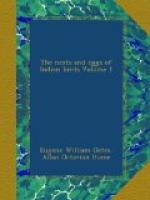The Pagoda or Black-headed Myna breeds throughout the more open, dry, and well-wooded or cultivated portions of India. In Sindh and in the more arid and barren parts of the Punjab and Rajpootana on the one hand, or in the more humid and jungly localities of Lower Bengal on the other, it occurs, if at all, merely as a seasonal straggler. How Adams, quoted by Jerdon (vol. ii, p. 330), could say that he never saw it in the plains of the North-West Provinces (where, as a matter of fact, it is one of our commonest resident species), altogether puzzles me.
Neither in the north nor in the south does it appear to ascend the hills or breed in them at any elevations exceeding 3000 or 4000 feet.
The breeding-season lasts from May to August, but in Upper India the great majority lay in June.
According to my experience in Northern India it nests exclusively in holes in trees. Dr. Jerdon says that “at Madras it breeds about large buildings, pagodas, houses, &c.” This is doubtless correct, but has not been confirmed as yet by any of my Southern Indian correspondents, who all talk of finding its nest in holes of trees.
The whole is thinly lined with a few dead leaves, a little grass, and a few feathers, and occasionally with a few small scraps of some other soft material.
They lay from three to five eggs.
From Hansie Mr. W. Blewitt writes:—“During June and the early part of July I found numerous nests of this species in holes of shishum, peepul, neem, and siriss trees situated on the bank of the Hissar Canal. The holes where at heights of from 12 to 15 feet from the ground, and in each a few leaves or feathers were laid under the eggs. Five was the greatest number found in any one hole.”
Recording his experience in the Delhi, Jhansi, and Saugor Divisions, Mr. F.R. Blewitt tells us that the Pagoda Myna breeds from May to July, building its nest in holes of trees, selecting where possible those most inaccessible. I have always found the nest in the holes of mango, tamarind, and high-growing jamun trees. Feathers and grass, sometimes an odd piece of rag, are loosely placed at the bottom of the hole, and on these the eggs repose.
“The eggs are pale bluish green, and from four to five form the regular number. I may add that only on one occasion did I obtain five eggs in a nest.”
“In Oudh,” writes Mr. R.M. Adam, “I took one nest of this species, in a hole in a mango-tree, on the 5th May, containing five eggs.”
Major C.T. Bingham remarks:—“All nests I have found at Allahabad and Delhi have been in holes in trees, in the end of May, June, and July. Nest strictly speaking there is none, but the holes are lined with feathers and straw, in which the eggs, four in number, are generally half buried.”
Lieut. H.E. Barnes tells us that this Myna breeds in Rajputana in June, and that he found one nest in that month in a hole of a tree with three eggs.




